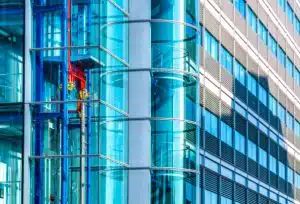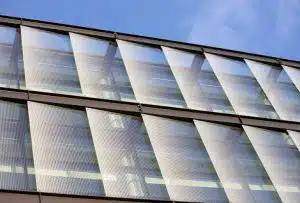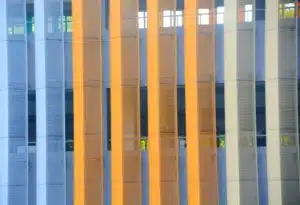1. Design Management Planning and Design Objective Management
1.1 Curtain Wall Design Should Emphasize Design Risk Prevention and Control
Qualified or even excellent curtain wall schematic design and construction drawings are the prerequisites for a high-quality curtain wall project. The detailed design of curtain wall system is the fundamental technical guarantee for a premium project. Therefore, in the project planning stage, design quality control must be regarded as a decisive step. Potential quality risks arising from the design process should be identified and eliminated as early as possible, providing theoretical support for subsequent design process control.
Project planning should emphasize the concept of design management. In excellent curtain wall project management, design planning should take precedence over all other management activities. It is necessary to propose the idea of design-led overall project management, and elevate design management to a higher level. That is, design planning combined with design risk response.
Here’s how these design management principles are applied at the project planning stage.
In this stage, a shared understanding should be established related to design risk prevention, potential risks, and appropriate response strategies. The followings are the relative five practices:
1.1.1 Prioritize Design Management
Curtain wall design management should be positioned as a core part of the overall project management structure.
1.1.2 Integrate Throughout Construction
Curtain wall design should be integrated into all phases of construction to ensure continuous oversight and coordination.
1.1.3 Engage Early in Key Stages
Curtain wall design should play an active role in key stages including material mock-ups, procurement, and prefabrication.
1.1.4 Incorporate Front line Feedback
Feedback from front-line construction teams should be regularly gathered and incorporated into the entire design process.
1.1.5 Empower Design to Veto
Curtain wall design team should be given the authority to veto critical construction techniques, procedures, and methods when necessary.
These risk control measures are for preventing irreversible design flaws and avoiding inherent quality defects caused by design issues. In doing so, they can provide a solid foundation for achieving high quality and well executed design outcomes.
Case Study on Proactive Design Risk Management
In one project, the design team identified a potential risk during the design phase. The issue was that the stone panels in the upper window roller blind area were oversized with a stability risk. To avoid this risk, the hanging method was revised with an independent vertical bracket added at the concentrated load-bearing area of the panel to eliminate the risk of displacement or detachment. Because this risk was accurately anticipated during the design planning stage and effectively managed during construction, the project successfully achieved proactive risk prevention.

1.2 Positioning and Planning of Curtain Wall Design
1.2.1 Properly Handling the Relationship Between Architectural Design and Curtain Wall Decoration Design
Curtain wall decoration design is a perfect supplement to architectural design. While architectural art is the realization of creative thinking, and curtain wall design should sublimate architectural design on this basis.
On the basis of reviewing architectural design, architectural design data is integrated according to the principles of decorative art. Curtain wall decoration design can be said to be the art of size, and reasonable size combination is the basic element to realize the designer’s conception. At the same time, designers must make it clear that curtain wall decoration design is not a negation of architectural design, nor is it a set of other things that are done without architectural design. It is actually a sublimation that makes the architectural conception perfectly realized and is the icing on the cake of architectural design.
In the in-depth design of the curtain wall of a certain project, the designer focused on the improvement of decorative art, superimposed a large number of horizontal lines to reflect the form of the table, and rhythmically expressed the series of repetitions of architectural elements. The visual overlap produces a compact and interesting effect. This fully demonstrates the artistic charm derived from the decorative construction and reflects the concept of curtain wall design as the icing on the cake of the building.
For a deeper look into how curtain wall design and architectural design can achieve seamless integration, you may refer to our dedicated article: Coordination Principles Between Curtain Wall Design and Architectural Design.
1.2.2 Balancing Practicality and Aesthetics
The harmony between practicality and aesthetics is fundamental to changing architectural decoration into an art form. Other art categories sometimes take aesthetics as the only purpose, but architectural decoration must be linked to practicality. Practicality is the basis of aesthetics, while aesthetics includes practicality.
When practical requirements conflict with the architectural design intent, curtain wall designers must explore alternative approaches that can address both functional and aesthetic needs so that the two can coexist harmoniously.
There are many projects that take practicality as the main purpose of curtain wall decoration, but fail to emphasize the aesthetics. The adjustment is to maximize the satisfaction of practical and aesthetic requirements and achieve the perfect unity of art and practicality.
1.2.3 Balancing Artistic Expression and Construction Feasibility
Artistic value has always been an important connotation of curtain wall design planning, but art cannot exist independently from technology. Curtain wall construction technology should provide conditions for the deepening of design. Besides, it is also the support of technology that enables many conventional decorative techniques to be flexibly applied in curtain wall design and exert artistic effects.
As a form of architectural construction that highly integrates art and engineering, curtain wall decoration engineering is not only a process of realizing functions, but also a process of shaping architectural works of art. In particular, during the entire process of curtain wall design and construction, designers and engineers work closely together, giving full play to their respective experience and technical means in handling decorative details, making precise adjustments to tiny sizes that affect visual effects, and using a variety of techniques to ensure the integrity and consistency of artistic expression. These lines, planes, and three-dimensional structures, supported by construction technology, ultimately constitute a curtain wall decoration entity that integrates technology and art, fully reflecting the artistic value and aesthetic height carried by curtain wall design.
Next in the Section Two, let us explore how to implement these aesthetic concepts into every engineering detail through meticulous curtain wall design process management.

2.Careful Management Throughout the Design Process to Achieve Refined Design Control
2.1 Understand the Design Target and Establish a Clear Baseline
Design process control starts with the designer’s pre-inspection of the project. The on-site measurement of curtain wall is a key link in determining whether the curtain wall design can be successfully implemented.
Although each project varies in specifics, the inspection items below should be included in all cases.
2.1.1 The elevation lines, grid lines, floor heights, total building height, and overall width of the civil engineering handover.
2.1.2 The current status of the old renovation project building.
2.1.3 The position and structural feasibility of embedded anchors.
2.1.4 Comparison between the curtain wall design dimensions and the actual site measurements.
Based on these findings, identify any discrepancies and propose correction plans to provide a reliable basis for the design.
2.2 Design Optimization Throughout the Entire Process from Design Planning to Construction
The design of curtain wall projects needs to examine the architectural design with aesthetic vision and artistic performance characteristics combined with implementation possibilities, and follow the established review mechanism.
The drawing review process and construction process of decoration projects are always inseparable from the optimization of the decoration objects. Such as:
2.2.1 Whether the arrangement of facade glass and stone panels and the size of the panels are reasonable. Is there room for adjustment, better solutions, or aspects that require coordination with the architectural design.
2.2.2 The width of stone joints, the proportion of open joints and decorative sealant joints must be simulated multiple times on computer models, and clearly indicated on finalized drawings.
2.2.3 The color of the decorative sealant joint needs to be tested on the sample wall in multiple schemes and finally confirmed by the designer.
The visual key areas such as external decorative signage, exterior stairs, and entrance features, etc. of the curtain wall must also be carefully processed through design optimization to ensure that the design language is fully implemented. For those detailed parts that architectural design does not fully cover, designers should supplement and optimize them with the concept of decoration to make up for the shortcomings and improve the overall effect.
Details determine success or failure. The refined management concept of curtain wall design requires that design control runs through the entire process of the project, from the deepening of drawings to the level of workers’ operations, and must be fully covered without omissions.
For example, in the layout design of stone and glass panels, consistency and artistry are often crucial. Any adjustment of details may affect the overall facade effect. However, in the actual construction process, arbitrary modifications often occur due to factors such as cost control, processing difficulty or material supply. Designers must resolutely reject them to ensure the implementation of design details.
2.3 Control of Design Feedback and Design Extension
Design feedback is an important part of the design process and an extension of refined management. It not only reflects the the designer’s careful consideration of the construction phase, but also reflects designer’s concept of project management. The design feedback at each stage serves as a re-examination of the in-depth design results. Meanwhile, it promotes the continuous optimization and extension of the design to ensure that the design intention is accurately implemented in the construction.
3. Conclusion
The improvement of curtain wall project quality depends on design risk pre-control, clear design positioning, refined management of the design process, and close coordination between design and construction starting from the project planning stage. Only when the design leads the whole process can quality defects be effectively avoided and a win-win situation of project quality and artistic value be achieved.





